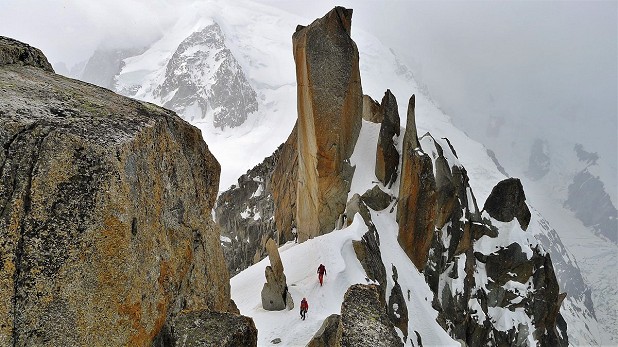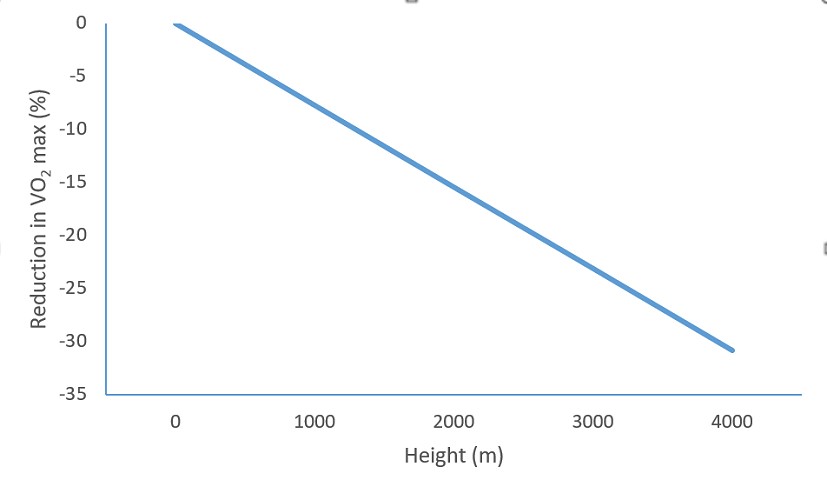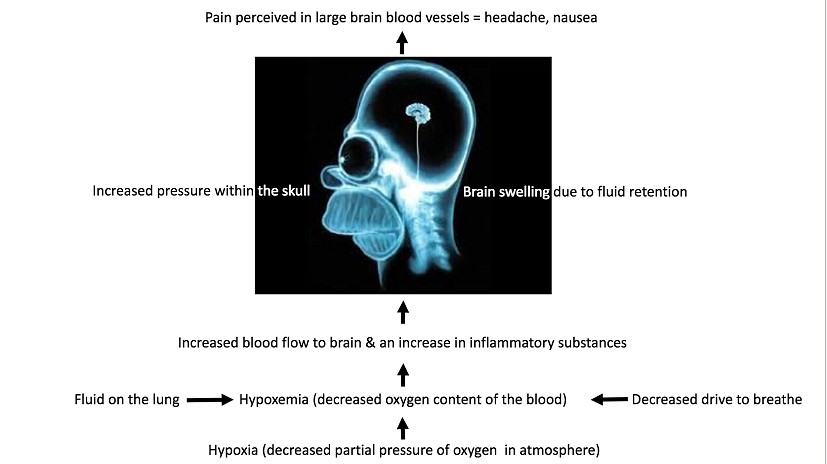High Altitude and Acclimatisation Part 1 - An Introduction
In the first of our four-part series on high altitude travel, Jamie Macdonald (high altitude physiologist at Bangor University) and Calum Muskett (professional climber and mountaineering instructor), explore the role of physical fitness in mountaineering success.
To be (fit), or not to be (fit), that is the question...
With Comic Relief 2019 just behind us, cast your minds back to Sport Relief 2009. That year's challenge also required nine celebrities to leave their comfortable television and music studios to climb to 5895m and attain the highest point on the African continent - Kilimanjaro. Hardened mountaineers were easy to dismiss the stunt as another guided charity trek on a non-technical peak, with porters doing all the hard work, made worse by the paraphernalia of the following TV crews. Fast and light it was not. But mountaineers and the masses alike were surprised to see that of all the celebrities struggling for breath on their TV screens, the beer swilling, pie eating, cigarette smoking, belly-sporting Chris Moyles seemed happiest in the rarefied air. And he summited successfully.
The success of Moyles is often quoted when the role of fitness for high altitude performance is debated. Invariably 'two ciggies' Don Whillans gets a mention too, and then personal experiences are regaled with glee of seeing young fit athletes doing poorly at altitude in comparison to their older, unfit counterparts. Unfortunately, all these anecdotal examples provide weak scientific evidence, and if we are brutally honest, are often quoted to justify a lack of personal preparation for the reciter's current or next adventure. But getting expedition-fit requires considerable time, effort and resources. So, what scientific data and applied best practice exists to help you prepare for altitude exposure?
First, we need to separate two factors – altitude illness and altitude performance. Surprisingly they are not as linked as you might imagine. Mountaineers are a (fool?)hardy bunch – mild and moderate acute mountain sickness (an altitude illness) often does not stop us from achieving our goals such as summitting (an altitude performance). Rightly or wrongly we tend to stoically push on through mild and moderate symptoms such as headache. So, let's deal with performance first, and altitude illness later.
In mainstream sports such as cycling, a common scientific approach is to study elite athletes and describe their characteristics. Such classical studies have also been completed in mountaineering on Reinhold Messner and colleagues. Following physiological testing, scientists were surprised that Messner was not super fit – his aerobic capacity (VO2 max, a measure of endurance fitness), was high (49ml/kg/min) but not extremely so (Tour de France cyclists are often more than 75ml/kg/min). Many have argued that this evidence suggests being fit is not helpful for altitude performance. However, this interpretation is over-simplistic.
Unlike mainstream sports such as cycling, numbers participating in mountaineering remain relatively small. Thus, there is little opportunity for characteristics and traits to become 'common' in elite mountaineers. In mass participation sports, there are multiple opportunities for competitive selection to occur and only the very best rise to the top. Take a sample of elite cyclists at the peak of their careers, the top few athletes in a pool of millions worldwide who cycle regularly for pleasure and competition, and you will observe common characteristics that explain their performance, such as high aerobic capacity. In mountaineering, competitive selection opportunities are few and far between. Take a sample of elite mountaineers, and the characteristics displayed will be disparate and inconsistent. Opportunity and psychology, rather than genetic factors, explain participation and success.
Messner, Whillans, and Moyles summitted their respective peaks partly because they had the chance to; not necessarily because they were genetically gifted to do so. This point also raises the tantalising prospect that sitting out there in the general population are other people who will be better suited to mountaineering and potentially "elite", but they have not had the chance to even try a pair of boots on.
Although this might explain why elite mountaineers are not super fit, and why unfit people have succeeded in mountaineering, why is it that we observe fit people "doing poorly" at altitude? It is especially important to separate illness and performance here. In terms of performance, we know that for every 1000m you climb, your aerobic capacity (VO2 max, a measure of endurance fitness) decreases by about 8% [see box 1]. This decrease in endurance fitness reduces performance. There is some evidence that reveals the fittest participants experience a greater decrease in aerobic capacity when at altitude. Some argue that this evidence 'proves' that being fit is not helpful for altitude performance. Again, this interpretation is over-simplistic. Although a fitter person may experience a greater percentage decrement in their aerobic capacity, their absolute aerobic capacity at sea level and when at altitude remains higher than a less fit person. Thus, a fitter person will have greater exercise capacity and fitness reserve for when speed is important (e.g. to avoid benightment or incoming weather).
Admittedly, scientific data is difficult to obtain in mountaineering because 'performance' is hard to measure. Summit success is perhaps the ultimate measure of mountaineering performance, but it will be influenced by other factors such as weather and partner failure. Mountaineering performance is hard to measure in the lab too – mountaineering activities typically last for hours or days – which is impossible to simulate and replicate. In any case, summit success and speed may not be every mountaineer's most important goal. Therefore, we took an alternative approach and studied sense of effort (how hard typical mountaineering exercise feels, sometimes referred to as Rating of Perceived Exertion) as a measure of performance. Sense of effort is a good measure of performance because sense of effort controls walking speed (the key determinant of whether a summit is successfully reached) and because it influences enjoyment (when exercise feels too hard it is not enjoyable).
In a group of typical trekkers and mountaineers, we observed that the fittest had lower sense of effort during simulated and actual mountaineering tasks. When speed was restricted (such as when walking with others tied into a rope together), the exercise felt easier and was thus more enjoyable. When speed was not restricted, the fittest could also select ascent rates that were quicker, increasing chance of summit success. So, if Moyles was fitter he might have enjoyed his climb more; if Messner had been fitter he may have even more summits at first attempt to his name.
But what about those cases we have all seen, of fit people getting sick? The physiological causes of altitude illness are only just being determined [see diagram below]. Recent lab studies by our group and others on the cause of acute mountain sickness suggests a mechanism that is not influenced in any conceivable way by fitness. Later studies by our group tested this theory in the field and showed that being fit did not increase risk of the most common altitude illness – acute mountain sickness. It is most likely that Moyles didn't get sick on Kilimanjaro because his skull was big enough to accommodate his brain as it swelled at altitude, not because being unfit protected him somehow.
There have been some observations suggesting that the fittest may be at increased risk of severe altitude illnesses, such as pulmonary oedema. However, these observations are difficult to interpret because ascent rate was not controlled (the fittest participants likely gained more altitude and completed more arduous exercise each day, and thus were at increased risk of illness regardless of their fitness level). We would argue that being fit may even protect against high altitude deaths. A study on Everest revealed that the most common symptom reported before death was fatigue – and being fitter is well established to reduce fatigue symptoms.
In summary, current evidence suggests that whether you are fit or unfit, you can get sick at altitude. However, being fit will increase your chance of summit success and your enjoyment. Nevertheless, the strongest evidence to put this argument to bed once and for all is yet to be generated – what happens when you increase fitness of a group of mountaineers, and compare their mountaineering performance to a group whose fitness has stayed the same? Perhaps a great study for the UKC community to participate in!
With all this talk of fitness, an obvious strategy that we could all use is to increase fitness before we travel to high altitude. Of course, this is not simple, requiring time, a little guidance or knowledge, and most importantly, motivation. However, the advantage of such a strategy is that it requires no specialist equipment, no altitude chambers, no hypoxic tents, and no lengthened altitude stays. It is thus accessible to all of us. Just be mindful of the double-edged nature of this approach. Being fit is advantageous, but if you exercise too strenuously (and ascend too rapidly) when at altitude, you will increase your risk of illness. Be fit, but move slowly until fully acclimatised.
In the next article in our series, we will discuss the acclimatisation process and explore classical and best practice acclimatisation profiles.



